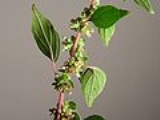
Parietaria
Encyclopedia
Parietaria is a genus of 20–30 species of flowering plant
s in the family Urticaceae
, native to temperate and tropical regions across the world.
They are annual
or perennial
herbaceous plant
s growing to 20–80 cm tall, with green or pink stems. The leaves
are alternate, simple, entire, often with a cluster of small leaves in their axils. The flower
s are bisexual
, produced in clusters of three to many together in the leaf axils. The fruit
is a small dry achene
.
Selected species
Sources:
Several species can be weed
s; the Mediterranean species P. judaica is widely naturalised
in the Americas, while the American P. pensylvanica is conversely naturalised in Europe.
Flowering plant
The flowering plants , also known as Angiospermae or Magnoliophyta, are the most diverse group of land plants. Angiosperms are seed-producing plants like the gymnosperms and can be distinguished from the gymnosperms by a series of synapomorphies...
s in the family Urticaceae
Urticaceae
Urticaceae, or the nettle family, is a family of flowering plants. The family name comes from the genus Urtica . Urticaceae includes a number of well-known and useful plants, including the aforementioned nettles, Ramie , māmaki , and ajlai .The family includes approximately 2600 species, grouped...
, native to temperate and tropical regions across the world.
They are annual
Annual plant
An annual plant is a plant that usually germinates, flowers, and dies in a year or season. True annuals will only live longer than a year if they are prevented from setting seed...
or perennial
Perennial plant
A perennial plant or simply perennial is a plant that lives for more than two years. The term is often used to differentiate a plant from shorter lived annuals and biennials. The term is sometimes misused by commercial gardeners or horticulturalists to describe only herbaceous perennials...
herbaceous plant
Herbaceous plant
A herbaceous plant is a plant that has leaves and stems that die down at the end of the growing season to the soil level. They have no persistent woody stem above ground...
s growing to 20–80 cm tall, with green or pink stems. The leaves
Leaf
A leaf is an organ of a vascular plant, as defined in botanical terms, and in particular in plant morphology. Foliage is a mass noun that refers to leaves as a feature of plants....
are alternate, simple, entire, often with a cluster of small leaves in their axils. The flower
Flower
A flower, sometimes known as a bloom or blossom, is the reproductive structure found in flowering plants . The biological function of a flower is to effect reproduction, usually by providing a mechanism for the union of sperm with eggs...
s are bisexual
Plant sexuality
Plant sexuality covers the wide variety of sexual reproduction systems found across the plant kingdom. This article describes morphological aspects of sexual reproduction of plants....
, produced in clusters of three to many together in the leaf axils. The fruit
Fruit
In broad terms, a fruit is a structure of a plant that contains its seeds.The term has different meanings dependent on context. In non-technical usage, such as food preparation, fruit normally means the fleshy seed-associated structures of certain plants that are sweet and edible in the raw state,...
is a small dry achene
Achene
An achene is a type of simple dry fruit produced by many species of flowering plants. Achenes are monocarpellate and indehiscent...
.
Selected species
- Parietaria alsinifolia Delile
- Parietaria australis (Nees) Blume
- Parietaria cardiostegia Greuter
- Parietaria cretica L.
- Parietaria debilisParietaria debilisParietaria debilis, commonly known as Pellitory or Native Pellitory, is a herb native to Australia and New Zealand.-Description:It grows as an annual herb from 7 to 40 centimetres in height, with green or white flowers...
G.Forst. - Parietaria diffusa Mert. & W.D.J.Koch
- Parietaria filamentosa Webb & Berthel.
- Parietaria floridana Nutt.
- Parietaria hesperaParietaria hesperaParietaria hespera is a species of flowering plant in the nettle family known by the common name rillita pellitory. It is native to the southwestern United States and northwestern Mexico, where it grows in many types of habitat, from coast to desert, dry to moist, and sometimes in disturbed areas...
B.D.Hinton - Parietaria judaicaParietaria judaicaParietaria judaica, common name Spreading Pellitory or Pellitory of the wall, is a species of herbaceous perennial plant in the family Urticaceae, commonly nicknamed sticky-weed. The plant's pollen is highly allergenic. In Australia it is also known as asthma weed, due to the high incidence of...
L. - Parietaria laxiflora Engl.
- Parietaria lusitanica L.
- Parietaria mauritanica Durieu
- Parietaria micrantha Ledeb.
- Parietaria officinalisParietaria officinalisParietaria officinalis, the Pellitory-of-the-wall, also known as lichwort, is a plant of the nettle family. Its leaves, however, are non-stinging. The plant grows on rubbish and on walls, hence the name...
L. - Parietaria pensylvanicaParietaria pensylvanicaParietaria pensylvanica is a species of flowering plant in the nettle family known by the common name Pennsylvania pellitory. It is native to much of North America including most of southern Canada, the entire United States, and northern Mexico. It grows in many types of habitat, including...
Muhlenb. ex Willd. - Parietaria praetermissa B.D.Hinton
- Parietaria ruwenzoriensis Cortesi
Sources:
Several species can be weed
Weed
A weed in a general sense is a plant that is considered by the user of the term to be a nuisance, and normally applied to unwanted plants in human-controlled settings, especially farm fields and gardens, but also lawns, parks, woods, and other areas. More specifically, the term is often used to...
s; the Mediterranean species P. judaica is widely naturalised
Naturalisation (biology)
In biology, naturalisation is any process by which a non-native organism spreads into the wild and its reproduction is sufficient to maintain its population. Such populations are said to be naturalised....
in the Americas, while the American P. pensylvanica is conversely naturalised in Europe.

